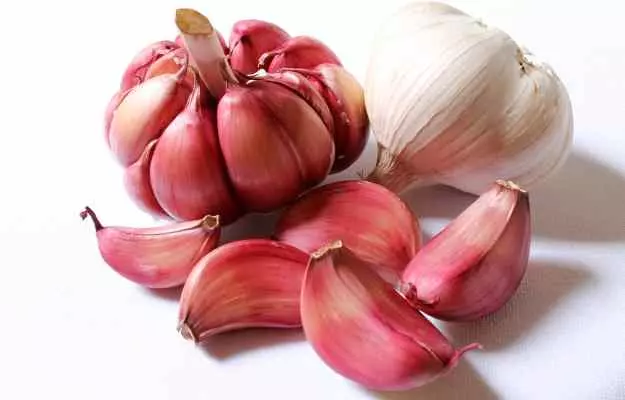Garlic is a culinary delight used widely for its healing properties and health benefits. It provides a distinct pungent kick to foods that are savoured by chefs all around the world. Garlic is originally a native of Middle Asia but has a history that is as vast as its culinary and medicinal usage. According to USDA (United States Department of Agriculture), garlic is one of the oldest crops to be cultivated.
Garlic was being used by Sumerians as early as 2100 BC. Ancient Indians used garlic for its healing and appetite developing benefits. You’ll be curious to know that garlic was considered as apt offerings for some deities in Greece. According to some historians, Olympic players in ancient Greece consumed garlic to improve their performance.
Legends of garlic usage and medicinal benefits are found in almost all major civilizations across the world including Iran, Tibet, Israel, Persians, Babylonians, the list goes on. In fact, the healing benefits of garlic have earned it names like “Natural antibiotic” “Plant talisman” and “Russian penicillin” from health experts all over the world. It might interest you to know that garlic was highly prized by Egyptians for its health-building benefits. In fact, it is mentioned on some "Egyptian tablets" inscriptions written on stone that garlic was used as a nutritional supplement for slaves who built the pyramids in ancient Egypt. A vast amount of wealth was spent by Egyptians for acquiring enough garlic for all slaves.
Did you know?
Garlic has five out of six ayurvedic tastes viz. Pungent, salty, sweet, bitter and astringent. It misses on only the sour taste.
Some basic facts about garlic
- Botanical name: Allium sativum
- Family: Alliaceae/Amaryllidaceae (Liliaceae)
- Common name: Garlic, Lehsun
- Sanskrit name: Lasuna
- Parts used: Bulbs, Tender shoots(for cooking)
- Native region and geographical distribution: Garlic plant is a native of Asia wherein, it is grown in India, China, Egypt, Europe, Iran, and Mexico
- Energetics: Hot
- Types and Varieties of Garlic
- Garlic Nutritional Facts
-
Garlic health benefits
- Garlic for oral health
- Garlic as an anticancer agent
- Garlic for cough and cold
- Garlic benefits for hair
- Garlic benefits for skin
- Garlic benefits for women
- Garlic benefits for men
- Garlic for arthritis
- Garlic for weight loss
- Garlic as an antibiotic
- Garlic for heart
- Garlic for cholesterol
- Garlic for diabetes
- How much garlic can be taken everyday
- How to use garlic
- Garlic side effects
Types and Varieties of Garlic
Types of Garlic
Garlic is a herbaceous plant with erect hollow stems that can grow to a height of 1m. Garlic bulb grows underground and it is divided into small bulbils which are commonly called as garlic cloves. On the basis of physical structure, garlic can be of two types.
- Hard-neck garlic:
Characterized by a stem that comes out from the middle of the bulb. They thrive better in harsher winters. Less number of cloves are present in a single bulb. - Soft-neck garlic:
No stem is present inside the bulb. Consists of many more cloves in every bulb (can go to 20). It grows in comparatively less harsh weather conditions and has a milder flavour as compared to hard neck garlic.
Varieties of Garlic: Green garlic and garlic scapes
Often when we talk about garlic, the terms green garlic and scapes are used interchangeably. But, there is a slight difference between the two.
Both of these are the same garlic that’s used in cooking but they are harvested at different stages of development of the garlic plant. Traditionally, green garlic is tiny undeveloped garlic bulbs. Garlic scapes, on the other hand, are shoots of garlic plant which are harvested after the formation of seed pods but right before the seed pods open. Garlic, as we commonly know it, is harvested after the opening of seed pods.
Garlic Nutritional Facts
Nutritional value of raw garlic per 100g is as follows
| Particulars | Quantity |
| Water | 58.6g |
| Carbohydrates | 33g |
| Fiber | 2g |
| Protein | 6.4g |
| Calcium | 181mg |
Energy per 100g: 149 kcal
Garlic health benefits
Garlic has a number of healing benefits for the human body. Most importantly, it is an anti-microbial, anti-oxidant and has excellent anti-inflammatory potential. Together these properties make it a champion for health and healing. Let’s talk about some health benefits of garlic.
- Beneficial for cardiovascular health: Garlic is best known for its cardiovascular benefits. It reduces the risk of heart diseases by managing cholesterol levels, preventing blood clotting and strengthening heart muscles.
- Anti-diabetic: Garlic is traditionally used as an anti-diabetic agent. Clinical studies have found that regular consumption of garlic is helpful in blood sugar maintenance in diabetic individuals.
- Promotes weight loss: Garlic helps in losing weight by burning excessive fat in your body. It has been clinically demonstrated that garlic consumption leads to a reduction in body weight within 24 days.
- Relieves common cold: Garlic has a warming effect on body and is thus effective in reducing common cold symptoms.
- Benefits for skin: Garlic improves circulation and increases skin regeneration, leading to a younger and brighter looking skin. It also prevents skin conditions like acne, psoriasis and eczema.
- Improves oral health: Garlic is an excellent antimicrobial, it helps balance the oral microflora, which, in turn, reduces the risk of oral infections and dental caries.
- Reduces menopause symptoms: Being an excellent antioxidant, garlic reduces oxidative stress and facilitate reduction in menopause symptoms such as mood swings and irritability.
Apart from the aforementioned benefits, garlic is also useful in relieving inflammation and preventing cancer cell growth. Studies are still going on to reap maximum benefits from this plant.
Garlic for oral health
Oral infections are a nuisance for teeth and gum health. According to dentists, most oral problems are caused by an imbalance in good and bad bacteria present in our mouths. Garlic, as an antibacterial is considered a superfood by dentists. It selectively kills the harmful bacteria while letting the good bacteria to survive in mouth thus improving the overall health of gums and teeth.
Studies conducted on non-vital (milk teeth, early teeth) in children suggest that treatment of infected gums with garlic extracts significantly reduces the total bacterial count.
According to a research published in The Indian Journal of Dental Research, garlic extracts may be effective in killing infection-causing bacteria like Streptococcus, Pseudomonas and Lactobacillus present in the oral cavity. However, in the absence of clinical studies, it is best to ask your dentist to understand the effects of garlic on teeth and gums.
Read more: Toothache causes
Garlic as an anticancer agent
Animal studies suggest that the sulfur compounds in aged garlic may have anti-tumour potential. While the exact mechanism isn’t known yet, it is speculated that garlic exhibits anti-cancer properties due to its antioxidants and tumour growth inhibition function. Due to absence of human studies, it is best to talk to your ayurvedic doctor.
Read more: Cancer treatment
Garlic for cough and cold
In Ayurveda garlic is considered a warm food that means it increases heat in the body. Garlic is a known remedy for cold. Clinical studies hint that garlic may be effective in fighting against cold and cough. But, there is a lot of controversial question against these studies.
Read more: Home remedies for common cold
Garlic benefits for hair
Garlic, when applied topically, has a lot of potential benefits for hair.
First, it is an antioxidant, that means it would help reduce signs of ageing and make your hairs stronger.
Secondly, garlic is a known antimicrobial, it’ll kill most of the harmful microbes that are potentially dangerous to your scalp.
Finally, studies suggest that garlic is an effective agent against bald spots. So, this one herb can give you shinier, stronger and healthier hair.
Read more: Hair loss prevention and remedies
See Similar Category Medicines Here
Garlic benefits for skin
Traditional and folk medicine uses garlic for its skin and wound healing benefits. Numerous studies have been done to test the mechanism and efficiency of garlic in improving skin health. Both animal and human studies confirm the skin healing benefits of garlic. In a study, administration of garlic powder was shown to increase blood circulation in the skin by 55%. Better circulation means healthier tissue. Additionally, garlic is a proven antimicrobial so it may help prevent infections in skin.
Garlic is known to be effective against skin conditions like psoriasis, corns, fungal infections and other skin conditions. Topical application of garlic gel, oil, garlic powder and extracts of garlic have been used in most of these studies.
Furthermore, antioxidant effects of garlic help keep the oxidative stress (caused by high level of toxic oxygen in the body which may be due to age or lifestyle problems) from hampering body and reduce the premature signs of ageing.
Lab studies suggest that garlic extracts increase fibroblasts (skin cells) thus keeping the skin younger. It is always advisable to refer to your ayurveda doctor to know the possible effects of garlic on your skin type.
Read more: Home remedies for face skin tightening
Garlic benefits for women
Garlic is priced for its antioxidant properties especially when it comes to women health. Menopause is one of the most important concerns for women at the age of 50 and above. According to doctors, menopause doesn’t only mark the end of the reproductive phase in women but it also causes a decrease in oxygen levels in female bodies. Menopausal symptoms like hot flashes, irritability, mood swings, vaginal dryness etc are some of the side effects that come with decreased estrogen (natural antioxidant of the body) and oxygen levels in the body.
In a study done with 30 postmenopausal women, it was found that administration of garlic reduces the oxidative stress in the body thus helping alleviate some of the symptoms that come with menopause.
Read more: Early menopause and premature menopause
Garlic benefits for men
There is a strong controversy when it comes to the efficiency of garlic in increasing male sexual functions. While some studies claim that administration of garlic is useful in increasing sperm count and testosterone levels in males; there are studies that indicate that garlic is also a potent spermicidal (kills sperms) and has a negative effect on male sexual functions. So, if you want to take garlic as a supplement for a better sexual health it is always advisable to talk to your ayurvedic doctor first.
Read more: Men's sexual problems and solutions
Garlic for arthritis
Garlic is widely used in traditional and folk medicine for treating inflammatory problems especially arthritis. Numerous animal studies hint at the usefulness of garlic as an anti-inflammatory agent in arthritis treatments. Lab studies claim that allicin, a natural compound present in garlic is responsible for reducing inflammation in organisms.
Due to lack of human studies, it is best to check in with your Ayurvedic doctor before taking garlic as a supplement for inflammatory problems like arthritis.
Read more: Arthritis diet
Garlic for weight loss
Obesity and weight issues are a rising global concern. Researchers believe that obesity is caused mainly by an excess of energy uptake in diet. Excess deposition of fat in the liver is just one complication that is associated with overweight people. This fat deposition decreases the efficiency of liver functions. And a decreased liver efficiency would not only affect the digestion process but it also has a detrimental effect on the overall working of the body.
Traditionally, eating garlic is known to be very useful for overall body health. Animal-based studies indicate that a natural compound S-allylmercaptocysteine present in garlic is effective against fatty liver.
Clinical studies suggest that administration of garlic tablets can help reduce overall body weight and amount of fat present in the body.
In a study, administration of garlic to a group of 210 people showed a marked decrease in body weight after a period of 24 days.
According to a review article published in the Journal of Chemical and Pharmaceutical Sciences, garlic has potent hypolipidemic (reduced cholesterol) and anti-obesity effects.
Read more: Weight loss diet chart
myUpchar Ayurveda Medarodh Fat Burner Capsule Boosts Metabolism and Digestion Burns extra fat. It has no side effects. Order today.
Garlic as an antibiotic
Numerous studies have been done to test the effectiveness of garlic as an antimicrobial. Most of these studies conclude that garlic has many potential antimicrobial compounds which are effective against bacterial, fungal and viral infections.
According to a study in India, garlic extracts are potent against the antibiotic-resistant strains of E.coli and Staphylococcus aureus. Another research article published in The Journal of Pharmacovigilance confirms the effectiveness of garlic extracts against these two antibiotic-resistant bacteria. It was further stated that allicin, a naturally occurring compound present in garlic is responsible for its antimicrobial properties.
Read more: Antibiotic resistance
Additionally, garlic extracts have also shown potent antimicrobial effects against fungi like Candida albicans and Aspergillus and against some viruses.
However, human studies need to be conducted to test the effectivity and any potential side effects of garlic extracts as a medicine. So, it’s best to check in with your ayurveda doctor to know more about the antimicrobial properties of garlic.
Read more: What are antibiotics
Garlic for heart
Heart diseases are mostly linked to factors like high cholesterol levels in body, free radicals, and development of blood clots in important arteries. As an antioxidant, hypolipidemic (reduces blood cholesterol) and anti-clotting plant, garlic is anything but a panacea for heart problems. In Ayurveda garlic is known as a tonic for the heart. Regular consumption of garlic cloves not only decreases blood pressure but also it reduces the chances of blood clotting and associated conditions like stroke and heart attacks.
According to a review article published in The Journal of Nutrition, numerous studies have been done to test the health benefits of garlic. At least 44% of clinical studies indicate that regular consumption of garlic has a potent effect in reducing cholesterol levels in blood and avoiding platelet aggregation in the blood (blood clotting). However, if you are suffering from a heart disease, it is always advisable to check in with your doctor before taking garlic as a health supplement.
Read more: Best cardio exercises for heart health
Garlic for cholesterol
High levels of cholesterol and harmful fats in body have been the major cause of heart-related diseases and atherosclerosis (fat deposition in arteries). This lifestyle and age-related problem are one of the leading causes of diseases and mortality in the world today. Dietary supplements and healthy lifestyle habits remain the best remedy for reducing or alleviating the risk factors in such diseases.
Garlic has been in use in Ayurveda for its benefits in managing cholesterol levels in our bodies and keeping the heart healthy.
A recent study conducted on a group of 50 healthy people (both men and women) confirm this claim of Ayurveda. In the study, consumption of raw garlic showed a substantial decrease in blood cholesterol levels after a period of 90 days. It was further suggested that daily intake of garlic reduces the low-density (bad) cholesterol in our bodies while increasing the amount of high-density (good) cholesterol. This balance in body fats then leads to a reduced risk of fat deposition in arteries and a subsequent decrease in possibilities of cardiovascular problems like stroke and heart attack.
Read more: Foods to reduce and control high blood cholesterol
Garlic for diabetes
In traditional medicine system, garlic is quite popular as an anti-diabetic. Recent clinical studies on patients suffering from diabetes suggest that garlic is effective in reducing blood sugar levels. The study involved two groups of people where one group was given garlic in the doses ranging from 0.05g to 1.5g for a varied period of days. Marked reduction in fasting blood sugar levels was found in people who took garlic regularly as compared to people who were not given garlic. What better than a food that serves your health and tongue at the same time?
In another study, a group of diabetic people with fasting blood sugar levels at 126 mg/dl were tested for the hypoglycemic (blood sugar reducing) effects of garlic capsules along with a capsule of a known diabetes medicine (metformin). Results were noted after 24 days and the group which received garlic and metformin showed marked decrease in blood sugar levels (around 3%) as compared to the group which received only metformin (0.5%). What better than a food that looks after your health and your tastes. It is always advisable to follow moderation while taking any food for its medicinal benefits.
Read more: Exercises for diabetes
How much garlic can be taken everyday
Ideally, 2 to 5 grams of fresh garlic and about 1 gram of garlic powder can be taken without much side effects. But dosage varies depending on the type of garlic, your body type, tolerance, and symptoms. So, it's best to consult an Ayurveda doctor if you want to take garlic in the form of a health supplement.
How to use garlic
Raw garlic is widely used for flavouring dishes like dips, salads, sauces, bread etc It provides a pungent sting to foods that are characteristic in most Italian dishes. Raw garlic is known to have a number of health benefits when taken on an empty stomach. Garlic oil is used in flavouring foods and in topical application for hair. However, garlic is also available commercially in the form of garlic tablets, capsules, and powder. If you are into herbal remedies, you can also look for garlic tea, tincture (alcohol extracts) and compress (paste as a band-aid).
How to store garlic
Garlic best survives in dark and dry conditions. Loose garlic cloves have a tendency to lose their freshness within a week. So, for a longer shelf life, it is better to keep the bulb intact right before you use it.
Garlic side effects
- Garlic is a natural blood thinner so if you are already on blood-thinning medicines or are about to undergo surgery, it best to not take garlic as a supplement.
- If you are on any prescribed medicine, its best to talk to your doctor before taking garlic as a health supplement.
- Long-term topical application of raw garlic is reported to cause skin irritation and burns in some cases. So, if you have a naturally sensitive skin its best to avoid garlic.
- Garlic is a natural hypoglycemic (reducing blood sugar) so if you are a diabetic on medicine it's better to talk to your doctor before taking garlic in any form.
- If you suffer from low blood pressure it’s safer not to take garlic as it is known to reduce blood pressure.
- Garlic is considered likely unsafe during pregnancy. Pregnant women are advised to best to follow moderation while consuming garlic and refer to your doctor to know what’s best for you and the baby.
Medicines / Products that contain Garlic
- Myupchar Ayurveda Nalpamaradi Ointment - ₹629
- Myupchar Ayurveda Maha Marichyadi Ointment - ₹629
- Rhuto Oil 30 ml - ₹86
- Dr. Patkars Apple Cider Vinegar Ginger, Garlic,Lemon & Honey with the Mother Vinegar 500ml - ₹966
- Usine Staminex Aphrodisiac Capsule - ₹203
- Rhuto Oil 60 ml - ₹145
- Cipzer Cobra Tila 10 ml - ₹2789
- Shuddhi Hrid Care - ₹1350
- Aimil Amalki Tablet (90) - ₹559
- Baidyanath Krimikuthar Ras - ₹174
- Baidyanath Lashunadi Bati - ₹128
- Himalaya Lasuna Tablet (60) - ₹228
- Orthodocs Joint Pain Relief Oil - ₹270
- Sri Sri Tattva Twaqure Ointment - ₹100
- Biogetica Neurorich Tablet - ₹1499
- Maha Herbals Plato Max Tablet - ₹230
- Jairishi Garlic Capsules - ₹343
- Garlic Pearls Capsule - ₹142
- Nisarg Organic Farm Blockage Open Syrup - ₹170
- Baidyanath Nagpur Gaisantak Bati (100) - ₹102
- DAV Pharmacy DAV Lipistab Tablet (60) - ₹396
- Herbal Canada Jeevan Amrit Ras - ₹495
- Wellness Mantra Biohart Capsule - ₹375
- Ontop Vedics Ortho 21 Advanced Oil 100 ml - ₹250
- Maha Herbals Maha Pain Relief Tablet - ₹169
- Kerala Ayurveda Kottamchukkadi Thailam - ₹155
- Cipzer Majoon-E-Piyaz 125 gm - ₹449
- Ontop Vedics Ortho 21 Advanced Oil 50 ml - ₹130
- Sultan Night Capsule 1 Month, Increase Stamina, Strength, Performance & Size - ₹2298
- Himalaya Anti Wrinkle Cream - ₹256
- Baidyanath Nagpur Gaisantak Bati (50) - ₹68
- Planet Ayurveda Garlic Capsule - ₹1450
- Shuddhi Hrid Care - ₹1350
- Zero Block X Syrup - ₹1045
- Zero Block Syrup - ₹930
- Jaffman Nurodex Capsules (20) - ₹75
- Sewa Hridyamrut Syrup 200ml - ₹225
- Aimil Amalki Tablet (30) - ₹196
- Swadharma Garlic & Ajwain Capsules - ₹699
- Baidyanath Gaisantak Bati (50) - ₹79
- Baidyanath Gaisantak Bati (100) - ₹135
- Ortho Veda Oil 50ml - ₹2900
- Krishnas Herbal & Ayurveda Cholesterol Care Juice 1000ml - ₹600
- Saral Massage Oil 100ml - ₹180
- Cipzer Heart Calm Capsule (60) - ₹899
- Rhuto Oil 100 ml - ₹235
- Kerala Ayurveda Kottamchukkadi Thailam 450ml - ₹345
- Farm Honey Garlic Honey 350gm - ₹360
- Cipzer Garlic Softgel Capsule (60) - ₹899
- Aayucure Choleston Tablet - ₹399
References
- Peyman Mikaili et al. Therapeutic Uses and Pharmacological Properties of Garlic, Shallot, and Their Biologically Active Compounds. Iran J Basic Med Sci. 2013 Oct; 16(10): 1031–1048. PMID: 24379960
- United States Department of Agriculture Agricultural Research Service. Basic Report: 11215, Garlic, raw. National Nutrient Database for Standard Reference Legacy Release [Internet]
- Biljana Bauer Petrovska, Svetlana Cekovska. Extracts from the history and medical properties of garlic. Pharmacogn Rev. 2010 Jan-Jun; 4(7): 106–110. PMID: 22228949
- United States Department of Agriculture Agricultural Research Service. The origins and distribution of garlic: How many garlics are there?. National Nutrient Database for Standard Reference Legacy Release [Internet]
- Majewski M. Allium sativum: facts and myths regarding human health. Rocz Panstw Zakl Hig. 2014;65(1):1-8. PMID: 24964572
- Ayaz E1, Alpsoy HC. [Garlic (Allium sativum) and traditional medicine]. Turkiye Parazitol Derg. 2007;31(2):145-9. PMID: 17594659
- Juan Wang, Xiuming Zhang, Haili Lan, Weijia Wang. Effect of garlic supplement in the management of type 2 diabetes mellitus (T2DM): a meta-analysis of randomized controlled trials. Food Nutr Res. 2017; 61(1): 1377571. PMID: 29056888
- Eidi A, Eidi M, Esmaeili E. Antidiabetic effect of garlic (Allium sativum L.) in normal and streptozotocin-induced diabetic rats. Phytomedicine. 2006 Nov;13(9-10):624-9. Epub 2005 Nov 2. PMID: 17085291
- Ashraf R, Khan RA, Ashraf I. Garlic (Allium sativum) supplementation with standard antidiabetic agent provides better diabetic control in type 2 diabetes patients. Pak J Pharm Sci. 2011 Oct;24(4):565-70. PMID: 21959822
- Hassan I El-Sayyad, Amoura M Abou-El-Naga, Abdelalim A Gadallah, Iman H Bakr. Protective effects of Allium sativum against defects of hypercholesterolemia on pregnant rats and their offspring. Int J Clin Exp Med. 2010; 3(2): 152–163. PMID: 20607041
- Ginter E, Simko V. Garlic (Allium sativum L.) and cardiovascular diseases. Bratisl Lek Listy. 2010;111(8):452-6. PMID: 21033626
- Yadav RK, Verma NS. Effects of garlic (Allium sativum) extract on the heart rate, rhythm and force of contraction in frog: a dose-dependent study.. Indian J Exp Biol. 2004 Jun;42(6):628-31. PMID: 15260118
- Shukry Gamal Mohammad, Kusai Baroudi. Bacteriological evaluation of Allium sativum oil as a new medicament for pulpotomy of primary teeth. J Int Soc Prev Community Dent. 2015 Mar-Apr; 5(2): 125–130. PMID: 25992338
- H. T. Ajay Rao, Sham S. Bhat, Sundeep Hegde, Vikram Jhamb. Efficacy of garlic extract and chlorhexidine mouthwash in reduction of oral salivary microorganisms, an in vitro study. Anc Sci Life. 2014 Oct-Dec; 34(2): 85–88. PMID: 25861142
- Ankri S, Mirelman D. Antimicrobial properties of allicin from garlic. Microbes Infect. 1999 Feb;1(2):125-9. PMID: 10594976
- Davood Soleimani, Zamzam Paknahad, Gholamreza Askari, Bijan Iraj, Awat Feizi. Effect of garlic powder consumption on body composition in patients with nonalcoholic fatty liver disease: A randomized, double-blind, placebo-controlled trial. Adv Biomed Res. 2016; 5: 2. PMID: 26955623
- Mouna Moutia et al. Allium sativum L. regulates in vitro IL-17 gene expression in human peripheral blood mononuclear cells. BMC Complement Altern Med. 2016; 16: 377. PMID: 27681382
- Thomson M, Ali M. Garlic [Allium sativum]: a review of its potential use as an anti-cancer agent. Curr Cancer Drug Targets. 2003 Feb;3(1):67-81. PMID: 12570662


























